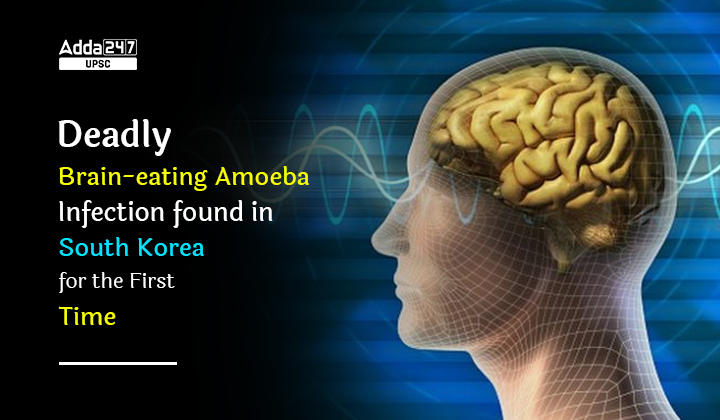Table of Contents
Brain-eating Amoeba Infection UPSC Relevance
Deadly Brain-eating Amoeba Infection: It has been in news as the first case of Brain-eating Amoeba Infection was reported from South Korea.
Brain-eating Amoeba Infection is also important for UPSC Prelims 2023 and UPSC Mains Exam (GS Paper 2- Issues related to health and human resources).
Brain-eating Amoeba Infection in News
- Recently, a rare and potentially deadly brain-eating amoeba has been identified in South Korea for the first time.
Brain-eating Amoeba Infection
- About: The brain-eating amoeba, known as naegleria fowleri, is typically found in warm freshwater and soil, and can cause a rare and severe infection known as primary amebic meningoencephalitis (PAM).
- First Case: According to the Korea Disease Control and Prevention Agency (KDCA), the infected individual in his 50s has died.
- The man had come back to Korea after a four month trip in Thailand.
- Transmission: Although human to human transmission of the infection is not possible, the KDCA has advised people to avoid water activities in freshwater lakes and to take precautions when engaging in water sports.
- The agency has also advised people to use nose clips or hold their noses shut when participating in water activities to prevent water from entering through the nose.
What is primary amebic meningoencephalitis (PAM)?
- About: PAM is a rare but often fatal infection that can occur when contaminated water enters the nose and travels to the brain.
- Symptoms: Symptoms typically appear within five days of infection and may include headache, fever, nausea, and vomiting, as well as a stiff neck, seizures, and altered mental state.
- In severe cases, the infection can lead to coma and death.
- Treatment: There is currently no specific treatment for PAM, and the infection can be difficult to diagnose due to the rarity of the amoeba and the lack of tailored diagnostic tests.
- Treatment typically involves a combination of medications to control inflammation and supportive care to address complications.
- Global Scenario: Though it is a rare disease and it is difficult to estimate the exact number of cases, there have been 143 reported cases in the United States from 1962 to 2018, with most occurring in the southern states.
- Globally, the World Health Organization (WHO) estimates that there are between 1,000 and 2,000 cases of the disease each year.
Primary Amebic Meningoencephalitis (PAM) FAQs
- What is naegleria fowleri?
Ans. &
- What are the effects of naegleria fowleri?
Ans. Naegleria fowleri can cause a rare and severe infection called primary amebic meningoencephalitis (PAM) when it enters the nose and travels to the brain.
- How do you get infected with naegleria fowleri?
Ans. Infection typically occurs when contaminated water enters the nose, often when people participate in water activities such as swimming, diving, or water sports.
- What is Primary Amebic Meningoencephalitis (PAM)?
Ans. PAM is a rare but often fatal infection that can occur when contaminated water enters the nose and travels to the brain.




 TSPSC Group 1 Question Paper 2024, Downl...
TSPSC Group 1 Question Paper 2024, Downl...
 TSPSC Group 1 Answer key 2024 Out, Downl...
TSPSC Group 1 Answer key 2024 Out, Downl...
 UPSC Prelims 2024 Question Paper, Downlo...
UPSC Prelims 2024 Question Paper, Downlo...




